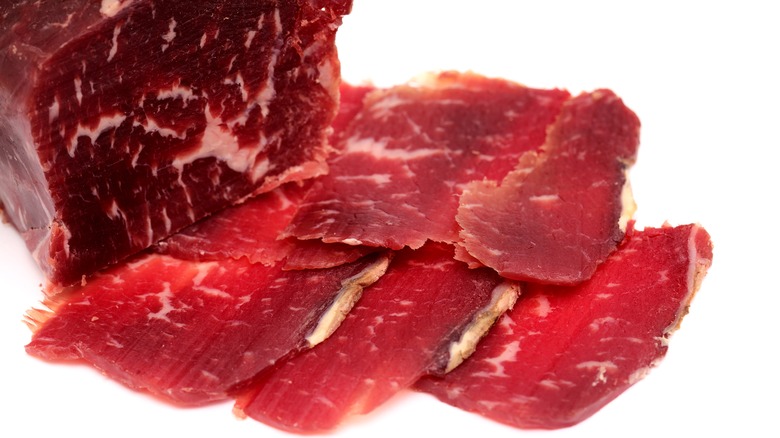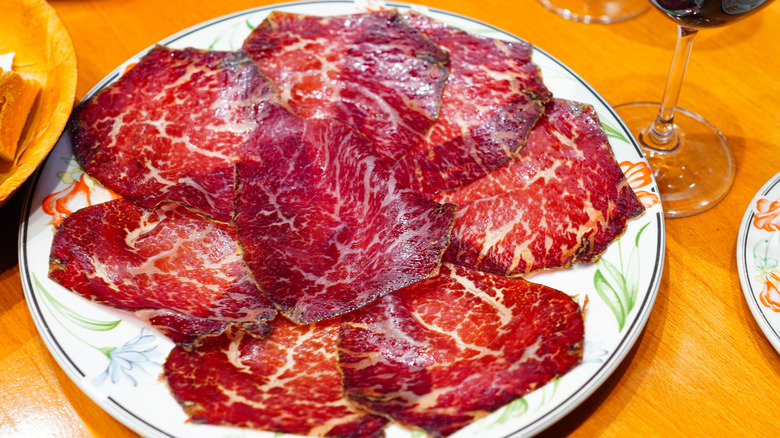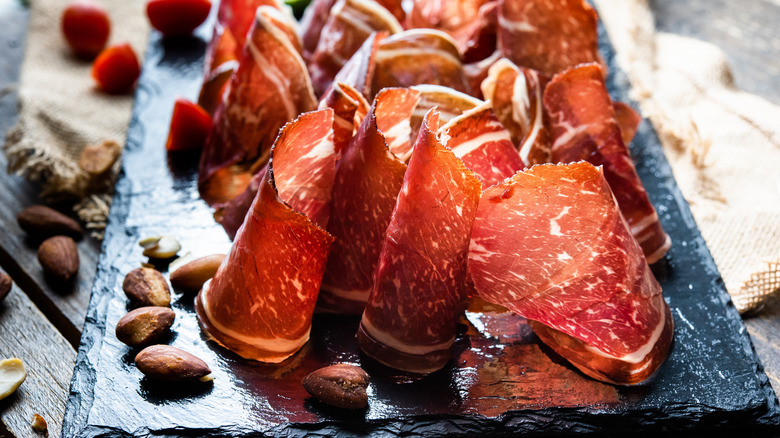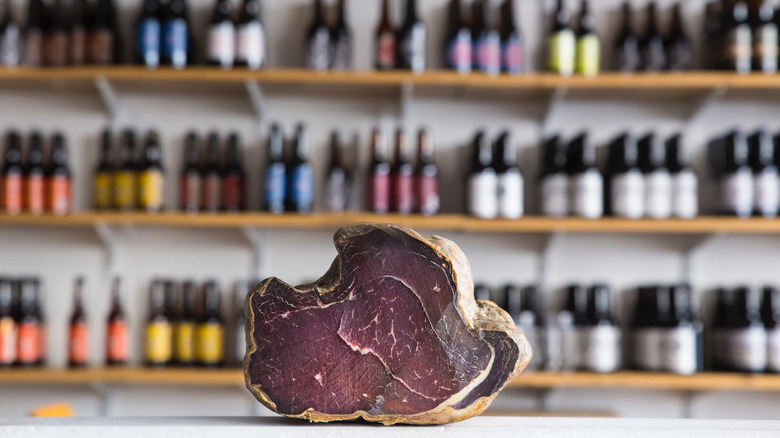Cecina: A Spanish Cured Meat That's Been A Delicacy For Centuries
From hot dogs to prosciutto, there are a variety of meat-curing techniques around the globe. And while Spain's most famous global contribution may be jamón ibérico, the country also crafts a delicious cured beef known as cecina. Celebrated for its centuries-old production, the dried beef involves precise techniques and a storied tradition, not unlike its pork cousin. Its taste is delectable– with a slight nuttiness, melt-in-the-mouth-tenderness, and just a hint of smoke. Although created through a salting method, there's no salinity present and a lack of chewiness, leading to a decadent mouthfeel. Factor in a long shelf life, and it's no surprise the product has been esteemed for centuries.
Served on a plate filled to the brim, the cured beef product is consumed all around Spain. However, its popularity is now starting to expand to markets abroad — especially amongst those who don't eat pork. Let's dive into how this beef delicacy came about.
History of cecina
Although eaten around Spain, the production of this dried meat is intertwined with the large, northwestern province of Castile and León. Here, the high elevation and arid environment provide ideal conditions to cure the meat. The result is known as cecina de León, and it has a protected geographical indication label in this region, especially noted around the town of Astorga.
Records demonstrate the production of cecina in this town dates all the way back to the 4th century B.C. During this time, the area was populated by Asturs, a unique Pre-Roman culture. Their settlement of Astorga was a bustling transit hub filled with traders and pilgrims. Astur locals prepared cecina in their homes and sold it to travelers. The protein-filled food provided an energy source similar to beef jerky, perfect for onward voyages. Although empires shifted and Astorga decreased in prominence, cecina production endured in the area.
Producing and preparing cecina
The quintessential type of cecina is made from beef. It utilizes a cattle breed hailing specifically from Castile, typically employing cuts like topside, silverside, flank, rump, and sections of the leg. There's a requirement for cows to be of at least five years of age and weigh at least 800 pounds. The food is also produced in the Basque region of Spain, where it has less-definite criteria for production.
Cecina can also utilize a different protein — goat, horse, bull, or rabbit. Combined with the influence of the process and environment during creation, this means there's a large range of cecina variations. Regardless, its crafting always starts by salting the meat, which is cut into large chunks. After several days, the excess salt is washed off, and the pieces are smoked in oak wood for around two weeks. The result is then air dried in special rooms, where temperature, humidity, and ventilation are carefully adjusted. After seven to 22 months of curing, the delicacy is finally finished.
How cecina is served
Once it's ready, the exterior crust is removed before serving. The cecina is sliced into thin pieces, similar to jamón ibérico. The cuts are then arranged to cover a plate, showcasing the tantalizing color of the pieces. Most often, it's eaten as a tapa on its own or alongside bread and cheese like manchego. However, some chefs also integrate the cut into cooking.
Popular recipes include a carpaccio, where the cut is covered in olive oil and served alongside nuts. Some also drape it on top of pizza, add to salads and sandwiches, and even serve it with fruit. When cooked, it usually only takes short durations of heat — limited to only a minute or two. Similar to forms of Spanish ham, cecina goes well with fruit, especially melon. And dishes that involve other cured Spanish products like serrano or jamón can be substituted with cecina for a beef-based charcuterie board.
Where to find cecina
To find the best cecina, it's important to purchase from an esteemed producer. The 11 Castillan-based producers with an EU-noted protected geographical indication are a dependable selection. Cecina produced in other regions is also likely to be delicious, just less regulated. Finding Spanish-made cecina in the U.S. was difficult for many years due to trade regulations. However, importation stateside recently started. There are now a handful of online purveyors, although not always easy to snag. A few brands have also started producing cecina in the U.S. For the best fortune of finding some in person, venture to a Spanish restaurant or specialty grocer.
Nothing beats trying the delicacy in Spain, where it's more readily available. Look for the cuts in the charcuterie section of a grocery, or better yet, head to a local tapas bar. And, of course, a bite of the delicious food is made better alongside a glass of Spanish wine.




